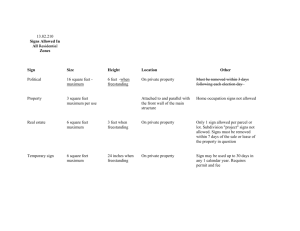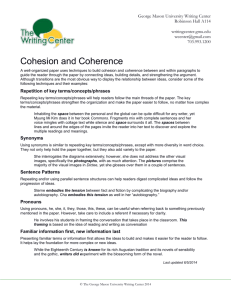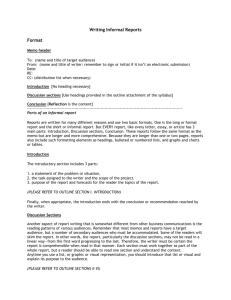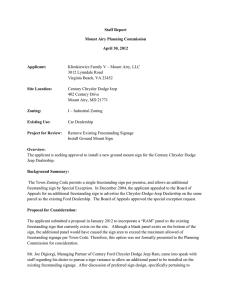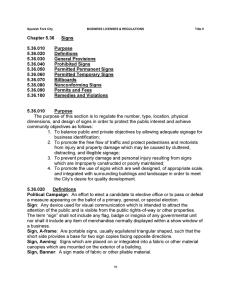OST164 Section 1 The Period
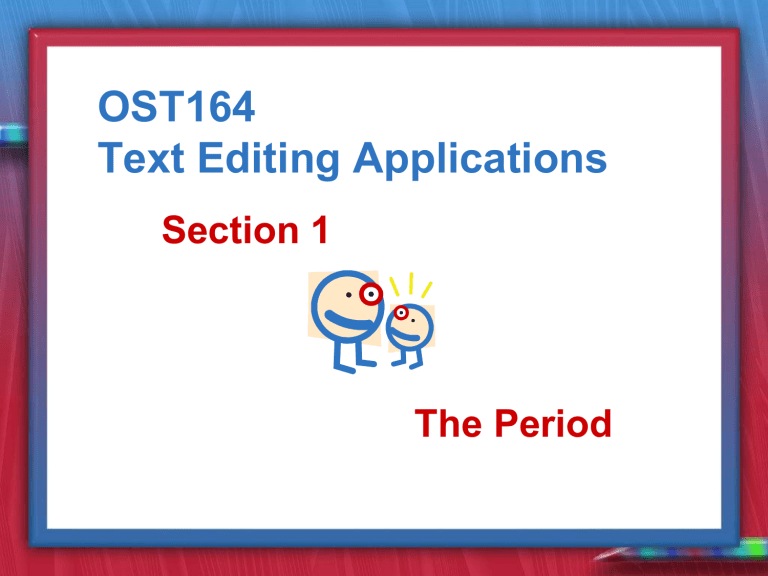
OST164
Text Editing Applications
Section 1
The Period
The Period ¶101
• At the end of a statement or command.
• To mark the end of an elliptical
(condensed) expression that represents a complete statement or a command.
Example: I’m done. No problem.
The Period ¶102
Use
one
space after the period at the end of a sentence.
The Period ¶103 a
• Requests, suggestions, and commands are often phrased as questions out of politeness.
• Use a period to end this kind of sentence if you expect your reader to respond by acting rather than by giving you a yes-or-no answer.
• Use a period only when you are sure that your reader is not likely to consider your request presumptuous.
The Period ¶103 a
1. Will you please call us at once if we can be of further help.
2. Would you please send all bills to my bank for payment while I’m out of the country.
3. May I suggest that you refer to computer criminals who break into other people’s computers as crackers, not hackers.
4.
If you can’t attend the meeting, could you please send someone else in your place.
The Period ¶103 b
If you are asking a favor or making a request that your reader may be unable or unwilling to grant, use a question mark at the end of the sentence.
The question mark offers your reader a chance to say no to your request and helps to preserve the politeness of the situation.
The Period ¶103 b
1. May I ask a favor of you?
2. Will you be able to have someone help me on the Woonsocket project?
3. Will you please handle the production reports for me while I’m away?
The Period ¶103 c
If you are not sure whether to use a question mark or a period, reword the sentence so that it is clearly a question or a statement; then punctuate accordingly.
Would you be willing to handle the production reports for me while I’m away?
Reworded sentence:
I would appreciate your handling the production reports for me while I’m away.
The Period ¶ 103 d
When you are addressing a request to someone who reports to you , you expect that person to comply. Therefore, a period can properly be used.
However, most people prefer to be asked to do something rather than to be told to do it.
A question mark establishes a nicer tone and often gets better results.
The Period ¶103 d
Consider using a question mark when your request to a subordinate involves something beyond the routine aspects of the job.
1. Will you please let me know what your vacation plans are for the month of
August.
2. Will you leave the report on my desk.
The Period ¶ 104
Use a period to mark the end of an
indirect question.
1. Frank Wilcox has asked whether an exception can be made to our leave-of-absence policy.
2. The only question she asked was when the report had to be on your desk.
3. Why Janet Murray left the company so quickly has never been explained.
4. We know what needs to be done; the question is how to pay for it.
5. I wonder who defined intuition as the knowledge that your salary won’t cover the cost of your children’s education.
The Period ¶ 105
Use a period (without a space before or after it) to separate a whole number from a decimal fraction.
Examples:
$5.50
33.33 percent
The Period ¶106
Use periods after numbers or letters that enumerate items in an outline or a displayed list.
Do not add a period if the numbers or letters are enclosed in parentheses .
Examples: a. “or” (a) 1. “or” (1) b. “or” (b) 2. “or” (2)
The Period ¶ 107 a
Use periods after independent clauses, dependent clauses, or long phrases that are displayed on separate lines in a list.
Also, use periods after short phrases that are essential to the grammatical completeness of the statement introducing the list.
Do this with numerical and alphabetical bullets.
The Period ¶ 107 a
Please get me year-end figures on: a. Domestic sales revenues.
b. Total operating costs.
c. Net operating costs.
NOTE #1: See how each line
completes the original sentence.
When you come back, we can:
• Go to the theater.
• Shop at the new mall.
• Visit some of your old friends.
NOTE #2: This applies to lettered, numbered, and bulleted items.
Today, I want you to:
1. Pick up a package from UPS.
2. Take the dog to the groomer.
3. Go by the dry cleaners before noon.
NOTE #3: Avoid the use of semicolons and a conjunction in a list.
The Period ¶ 107 b
No periods are needed after short phrases in a list if the introductory statement is grammatically complete or if the listed items are like those that would be found on inventory sheet or a shopping list.
Please purchase the following items when you go to the store:
1. Eggs
2. Bacon
3. Milk
Bring the following items with you come to class tomorrow:
(a) Pencil
(b) Notebook paper
(c) Pencil sharpener
The Period ¶108
(a)Use a period after a run-in heading (one that begins a paragraph and is immediately followed by text matter on the same line.)
I nsuring Your Car
.
Automobile insurance is actually a package of six different types of coverage.
(b) Omit the period if the heading is freestanding (displayed on a line by itself.)
Insuring Your Car
Automobile insurance is actually a package of six different types of coverage.
The Period ¶108 (cont’d)
However, retain a question mark or an exclamation point with a freestanding heading if the wording requires it.
Is it Legal ?
Investing your money so as to….
A period follows a run-in expression like
Table or Figure , even though the heading as a whole is freestanding.
Table 6 .
SALARY RANGES
Figure 2-4 .
Departmental Staff Needs
The Period ¶109
Do NOT use a period:
After letters used to designate persons or things ( Client A, Class B )
Exception: Use a period when the letter is the initial of a person’s last name ( Mr. A. for Mr. Adams )
After contractions ( such as cont’d )
